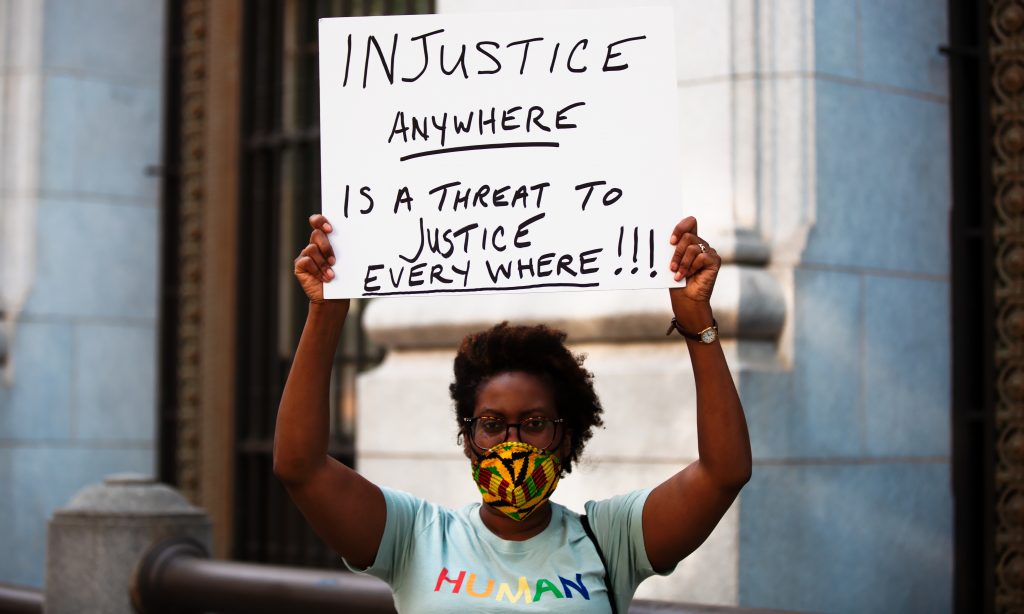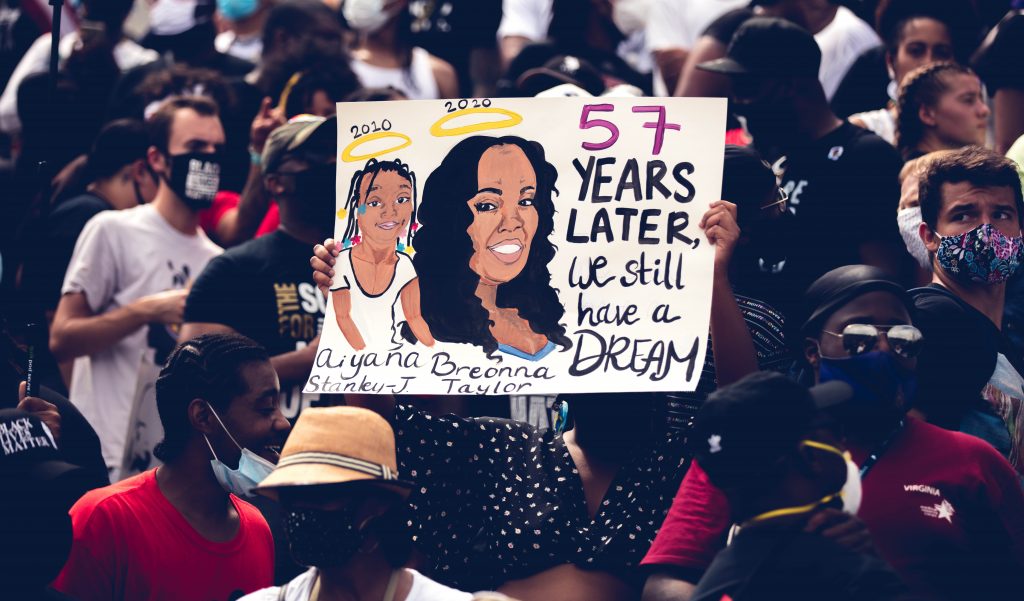On August 28, 2020, a march organized by Rev. Al Sharpton, Martin Luther King, III, and the families of Trayvon Martin, Ahmaud Arbery, Geroge Floyd, Breonna Taylor, and Eric Garner will take to Washington, DC to continue the fight for criminal justice reform and Black equality in America. For 2020, the March on Washington will require special health regulations to help combat the spread of COVID-19, but the spirit of the march is as alive and vibrant as ever.
The Commitment March bears the rallying cry “Get Off Our Necks” in honor of George Floyd, killed by police officer Derek Chauvin who knelt on his neck for eight minutes and 46 seconds, resulting in his untimely death. George Floyd’s murder became a catalyst for renewed protests against police brutality, which saw demonstrations here in New York City and violent clashes with the NYPD as peaceful protestors were run over with police vehicles, tear-gassed and shot with rubber bullets, and even shoved against concrete.

Rev. Sharpton’s National Action Network (NAN) is a major organizer of this year’s march. They have released the two-day schedule of programming, COVID-19 safety guidelines, and their mission for the March on Washington.
The Nitty-gritty Details of the March on Washington
The program begins virtually on August 27 from 8-10 pm EST with “The Call.” Speakers are not yet known but expect programming such as speeches, musical performances, and reflections. There will probably be appearances by young activists, spiritual leaders, and artists.
For more information and to sign-up for the virtual events visit: https://2020march.com/
On August 28, the day is divided into two parts. There is “The March” from 11AM-3PM EST and “The Charge” from 9-11PM EST.
Before the march, speeches and additional programming will be streamed across social media channels. The March will kick-off at 1 PM at the Lincoln Memorial and end at the Martin Luther King Jr. Memorial.
After the conclusion of the march, The Charge promises a keynote address and a musical performance. Details are scarce at the moment. Make sure you’re signed up at the website above to stream the virtual events.
See Also: ICE Cracks Down in NYC While Covid Rages On
The March on Washington’s Mission
The March on Washington is designed to honor the historic moment fifty-seven years ago when Martin Luther King Jr. gave his “I Have a Dream” speech. Though the original march had a major focus on economic equality for Black people and access to jobs, as emphasized by King’s speech, the fundamental movement for equality is something Black Americans are still fighting for today.

Editorial credit: Johnny Silvercloud / Shutterstock.com
This march is a recommitment to King’s dream and is amplifying the call for police accountability and reform. It has a secondary mission to mobilize Americans to vote come November.
At the highest level of government down to the most local, politicians have been pushing voter suppression tactics designed to keep People of Color low. From Jim Crow-era policies to today, the right to vote continues to be under assault. New York Times Bestselling author Angie Thomas recently tweeted about discovering her mother’s voter registration mysteriously disappeared.
A number of people also responded after being prompted to check their own statuses.
See Also: The Secret History of Washington Square Park
One thing is clear: the message of The March on Washington is still relevant today. We have not yet achieved King’s Dream.
How Does COVID-19 Impact the March on Washington?
No one can forget we are living through a pandemic. It impacts everything we do. The March on Washington has had to put safety measures in place to follow relevant health guidelines.
D.C. Mayor Muriel Bowser has spoken on the event, stating the need for two-week quarantines to be in effect for out-of-state travelers where COVID-19 is still spreading at high rates. New York is not on the DC quarantine list.
Speaking about the list at a press conference on July 31, Mayor Bowser said, “…no one should look at the quarantine order as a punishment. It’s guidance from health officials to keep us safe. So people who are making personal decisions to travel – or other activities for that matter – need to consider how it impacts other people. You have to follow health guidance….anybody traveling to the city, for any purpose, must consult that guidance.”
To help enforce this for public safety, permits may not be granted to buses from certain states.
Masks will be required along with social distancing. Many community groups organizing trips to the march have said they received donations of masks and hand sanitizer to keep marchers safe. One report claimed the event would be seated with socially distant chairs and a monitored entrance and exit but did not clarify if this was about the speeches preceding the march. Other safety measures include temperature check stations and sanitizer stations set up across the city.
COVID-19 Won’t Stop People From Attending the March
Despite the pandemic, we saw firsthand people came out to protest the murders of George Floyd and Breonna Taylor. In large cities like New York, these protests did not contribute to spikes of the virus largely thanks to the use of masks. These protests have still continued, even if they are not getting national news coverage anymore.
The March on Washington will be no different. Buoyed by the recent death of civil rights icon John Lewis, who was last-living speaker from the original march, coming out to honor his memory, life’s work, and his politics, is a focal point of the march.
Additionally, life under the pandemic has disproportionately affected Black Americans.
The following Vox video explains how American history, laws, and businesses have contributed to high pollution, poverty, and sickness in Black communities.
These injustices do not afford Black people the privilege to avoid a protest for fear of getting COVID-19. In fact, Black workers disproportionately make up the body of essential workers. Many Black workers in America are working on the front lines to provide services everyone needs, despite the fact they are some of the most at-risk people. Oftentimes work these jobs without comprehensive benefits to support themselves and their families.
The disproportionate make-up of essential workers in our country is a stark reminder of systemic racism in American institutions. These facts make the March on Washington for Jobs and Freedom in 1963 still incredibly relevant today.
These injustices are the reasons Black Americans march, and why white people and People of Color should be marching with them.
Follow #GetUpDC on Twitter to see videos and posts of people who are planning to attend the March on Washington explain their reasons.
May they motivate you to march, attend virtually, and to vote in November.


